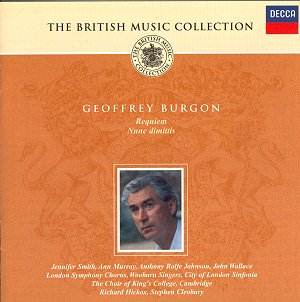Geoffrey Burgon is a versatile and prolific composer
who has composed a great number of vocal and choral music including
several large-scale choral-orchestral works of which the magnificent
Requiem completed in 1976 for the 1976 Three Choirs Festival
in Hereford is one of his first major achievements.
For his setting, Burgon interpolated the traditional
Latin text with various texts by St John of the Cross, sung in Spanish.
(Prior to completing his Requiem, Burgon had composed
another work on words by St John of the Cross, Canciones del Alma
(1975) for two counter-tenors and strings.) Burgonís Requiem
falls into three large parts (Requiem Aeternam, Dies Irae and
Libera Me) of which the Libera Me is the longest; and
the work is scored for three soloists (soprano, countertenor [sung here
by a mezzo-soprano] and tenor), chorus and orchestra with a fairly large
percussion section, though this is used quite sparsely throughout the
piece. Burgonís Requiem is mainly restrained and introvert,
some sort of present day Fauré Requiem rather than of
the more explosive, dramatic kind. In Burgonís hands, the Dies Irae
is literally awe-stricken and avoids any big angry outbursts, such as
are found, say, in Verdiís Requiem or in Brittenís War
Requiem, although the music may still rise to some massive,
transient outbursts. There are many gripping moments, such as the mysterious,
dark-hued opening of the Requiem Aeternam; or the first stages
of the Dies Irae progressively building-up towards the organís
fortissimo outbursts. The third part Libera Me opens with
a long monologue sung by the tenor (on words by St John of the Cross)
leading into a second aria for tenor (again in Spanish). This is followed
by the Agnus Dei in which the mezzo-soprano and soprano join
for a beautiful setting of En mi pecho florido (incidentally
also set by Petrassi in his Noche Oscura) whereas the
chorus continues the Latin Agnus Dei. A short orchestral interlude
leads into the Lux Aeterna, later leading into the recapitulation
of the Requiem Aeternam. From then on, the dynamic level progressively
thins-out and the Requiem ends with softly shimmering
bell sounds and flutes fading away into the distance.
Burgon wrote a huge amount of film scores and of incidental
music for TV series, one of the most famous being his score for Tinker,
Tailor, Soldier, Spy after John Le Carré. The end music was
a particularly striking setting of the Nunc Dimittis scored for
one single treble voice, trumpet and organ (there also now exists a
version with string orchestra) but no chorus at all, as the wording
of the insert notes and of the back cover erroneously mention.
Hickoxís reading of Burgonís superb Requiem
was much acclaimed when it was first released. Excellent soloists, all
in fine voice, superb choral singing, splendid orchestral support and
recording. It is good to have this wonderful performance available again.
A small grumble however for the production of this release, as many
other in this most welcome British Collection, is often rather
sketchy and does not include the texts used in either piece.
Hubert Culot
See also review by John
Leeman


